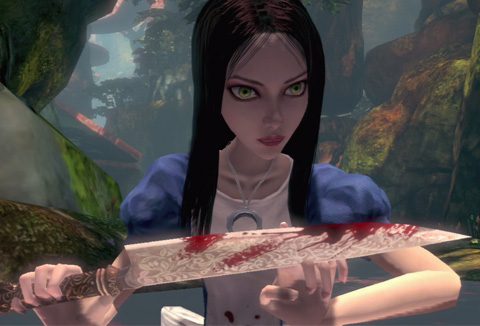Back at the turn of the century, a little PC game by American McGee was released, creating a follow up story to Lewis Carroll’s Alice in Wonderland in gruesome fashion. It turned a classic tale of wonder into a cornucopia of nightmare visions. The game developed an incredible cult following, and now, 11 years out, we finally get a sequel. Alice: Madness Returns is a perfect example of how difficult it can be to balance style and substance while living up to the expectations of long time fans. The focus of McGee is certainly on the style side of things, which leaves gaps in the gameplay, but provided you can look past the hiccups, it is hard to hold too much against him.
Madness Returns picks up after the events of the first game, with Alice undergoing therapy at a half-way house to help recover the memories of her family’s demise and cure her of her Wonderland fixation. The opening sequence sets the tone for the game, a vivid hallucination that takes the happy, lighthearted world of Lewis Caroll and feeds it piece by piece to a pack of ravenous zombies. We are immediately left to question whether Alice is truly mad, of if there are more sinister forces at work.
Much like Alice before it, Madness Returns attracted so much attention because of the aesthetic. McGee is an artist with a theme, and that theme is the questionable nature of sanity, and as such, each level of Wonderland is equally beautiful and grotesque. Rolling heads, mumbling the madness of the recently decapitated pass in front of candy flowers and sprawling valleys of milk and honey. The intentionally horrifying levels contain moments of tranquility and beauty, all which serves to magnify how troubling the events unfolding really are. Each level fits into the overall look and theme, and the deeper you go, the more alive Wonderland becomes, even as it’s slowly dying beneath you.
In order to traverse the insanity of Wonderland, Madness Returns combines third person action and platforming, with a liberal sprinkling of puzzles throughout each level. Alice is given a number of weapons throughout her journey, all based off of the source material, and each can be used in quick succession without pause, making large battles incredibility fulfilling and enjoyable. Enemy encounters force you to learn each weapon, and prevent you from relying too heavily on any one of them. Combat quickly becomes the most immersive gameplay element, leaving you craving new nests of bad guys simply to try out new tricks. Alice’s ability to shrink allows for travel into hidden areas, and illuminates platforms and paths otherwise hidden, giving you numerous reasons to explore.
While all of the individual elements of Alice work, the desire to show off the macabre sets and levels seems to become more important. Levels are devoid of major boss encounters, they are simply fetch quest after fetch quest, forcing you to see every inch of the level in order to move on. Much of the game is spent finding more questions than answers, which can make holding onto the deeply enigmatic narrative difficult. During the first half of the game, losing the story is far too easy, and by the time events culminate into real answers, the frustration with the meandering early levels can put a damper on the impact of major revelations. It becomes more and more apparent that the look of each level was more important than the technical details of platforming or creating enjoyable and original puzzles. During the final chapters, it became easy to begrudge the art simply because it is apparent how much it takes away from the gameplay aspects. Beautiful scenery and haunting passages are only fun if traveling through them is a pleasure, not a chore.
Releasing a sequel to Alice, now with the backing of EA and the major consoles, is a bright spot for gamers simply because it shows how much creativity is still out there. Alice managed to take typical combat mechanics and make them feel fresh and addictive. It also creates a world alive with terror and mystery. Yet, it still feels like a first step. There are concepts and ideas that feel hesitant and experimental. Alice is absolutely worth a look, but it promises more than it delivers. It is hard to not enjoy Madness Returns for the first few hours, but the obvious lack of polish drags down the fun after that. Perhaps another installment will finally be the game Madness Returns could have been.
Review
| Pros | Cons |
|---|---|
| Undeniably gorgeous settings. Combat is top notch. The story pays off if you stick with it | Too many gaps in constancy. The art is more important than the gameplay |
| Rating |





